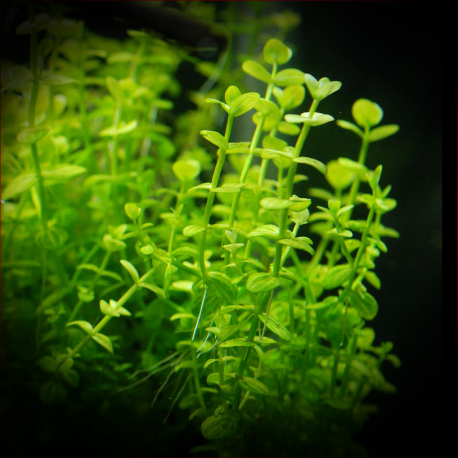More info
Datasheet
| Aquarium Compatible | yes |
| Plant Outdoor | unknown |
| Plant Emersed Growth | yes |
| Temperature Tolerance | 4°C / 39.20°F - 34°C / 93.20°F |
| Temperature | 22°C / 71.60°F - 26°C / 78.80°F |
| Carbonate Hardness | 0-14 kh |
| pH Value | 5-8 ph |
| Light | medium-high |
| Carbon Dioxide (CO2) | 10-40mg/lmg/l |
| Nitrate (NO3-) | 10-50mg/lmg/l |
| Phosphate (PO43-) | 0.1-3mg/lmg/l |
| Potassium (K+) | 5-30mg/lmg/l |
| Iron (Fe) | 0.01-0.5mg/lmg/l |
General Description
Lindernia rotundifolia, previously known as Gratiola rotundifolia, is a species of aquatic plant belonging to the family Linderniaceae. It is a stem plant with emersed growth habit. This plant is identified by its rounded leaves and can thrive in a variety of water conditions.
Aquarium Suitability
This plant is suitable for aquariums, making an excellent midground or foreground addition, especially when grouped together. Its ease of care and hardiness make it a popular choice for both beginner and experienced aquarists.
Demands and Hardiness
With a difficulty level rated as easy, Lindernia rotundifolia thrives in water temperatures ranging from 22-26°C and demonstrates tolerance for temperatures between 4-34°C. It requires medium to high light levels and CO2 levels between 10-40mg/l for optimal growth. The plant can adapt to a pH range of 5-8 and low to moderate levels of carbonate hardness.
Aquascaping & Usage
In aquascaping, this plant can be used to create lush, green foregrounds or midground clusters, enhancing the overall visual appeal of the aquarium. Its ease of propagation through seeds and cuttings makes it a versatile option for aquarists looking to fill in empty spaces.
Propagation
Propagation of Lindernia rotundifolia can be easily achieved through both seeds and cuttings. This plant has a high success rate when propagated in aquatic environments, allowing for the expansion of its presence in the aquarium setup.
Habitat and Distribution
Natively found in diverse habitats, including wetlands and shallow waters, Lindernia rotundifolia has a widespread distribution across various regions. Its ability to adapt to different water conditions and habitats makes it a resilient species in nature and popular among aquarists seeking versatile aquatic plants for their tanks.

